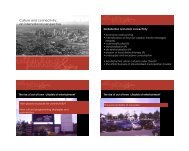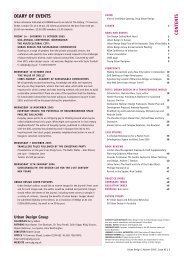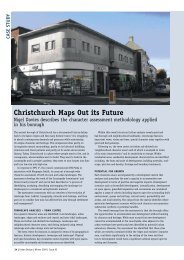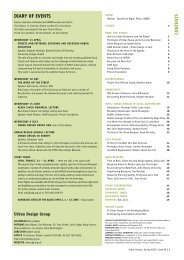URBAN MORPHOLOGY - urban-design-group.org.uk
URBAN MORPHOLOGY - urban-design-group.org.uk
URBAN MORPHOLOGY - urban-design-group.org.uk
You also want an ePaper? Increase the reach of your titles
YUMPU automatically turns print PDFs into web optimized ePapers that Google loves.
Every single <strong>urban</strong> feature<br />
should therefore be viewed<br />
according to its inner logic<br />
TOPIC<br />
Opposite page Carlo Aymonino, ROMA-EST proposal for<br />
the XV Milan’s Triennale, 1973. The ‘città per parti’<br />
concept as an analytical method and project model:<br />
the city is defined as a bricolage of well known<br />
architecture.<br />
Above Hans Kollhoff, project for an analogous city, 1976.<br />
A collage of well known architectural typology is<br />
assumed as a possible model for redefining the modern<br />
<strong>urban</strong> space.<br />
Left A proposal of the ‘net–city’, 1988: OMA/Rem<br />
Koolhaas first sketches for Euralille, the new city as an<br />
arrangement of autonomous fragments.<br />
In this new framework, the concept of building type is no<br />
longer capable of meeting new needs, mainly expressed by the<br />
‘generic city’, theorised by Rem Koolhaas 6 . The main cause seems<br />
to be the desire for flexibility and continuous transformation<br />
expressed by the new economy. The hierarchical structure<br />
of the city has been replaced by a network of centres located<br />
into the most profitable nodes within it, in order to intensify<br />
and multiply mutual connection. Because the configurations<br />
of the ‘net-city’ are always changing in close relation to the<br />
development of the market, the buildings are as anonymous<br />
as possible and tend to isolate each other in order to freely and<br />
rapidly meet new needs. Once again, as with functionalism,<br />
the architecture refuses to be ‘representative’ of shared values,<br />
making itself a matter of language, and aiming to offer itself<br />
simply as a working tool for programmatic purposes.<br />
If and when architecture aspires to express contemporary<br />
values in <strong>urban</strong> <strong>design</strong> practice, we notice recurrent strategies:<br />
to blur into infrastructural iconicity, emphasising the role<br />
of mobility in current <strong>urban</strong> culture; to create of an artificial<br />
landscape merged into the natural one, expressing the endless<br />
widening of the traditional city boundaries; to compete with<br />
<strong>urban</strong> centres and become a self-sufficient small town, artificially<br />
replacing the scale of traditional patterns of public space, erased<br />
by <strong>urban</strong> sprawl. By admitting only a partial focus on reality,<br />
all of these, however, inevitably avoid the complexity of the<br />
current <strong>urban</strong> landscape where traditional <strong>urban</strong> nuclei, modern<br />
peripheries, fragments of productive farmland, territorial<br />
infrastructures, productive settlements and wastelands coexist<br />
close to each other to produce something which, in its entirety,<br />
reminds us of the idea of a ‘collage city’, as defined by Colin Rowe<br />
and Fred Koetter 7 , even if shown at a wider scale than the original.<br />
This ‘realistic’ framework opens up new perspectives to the<br />
possible application of the concept of building type in <strong>urban</strong><br />
<strong>design</strong> strategies. The global economy has in fact accelerated the<br />
perception of differences as a matter of identity for the new city,<br />
bringing together into a new kind of unity territorial features<br />
which previously belonged to autonomous scales and purposes.<br />
It therefore no longer seems possible to define a unique solution<br />
and to pursue an ideological approach to the new <strong>urban</strong>ised<br />
territories. On the contrary it seems helpful for <strong>design</strong> practice<br />
to work on specific fragments. Every single <strong>urban</strong> feature should<br />
therefore be viewed according to its inner logic, implying a<br />
systematic deconstruction of its principles which are individual<br />
and cannot be generalised. This approach will inevitably lead<br />
us to recognise the internal differences which lie at the heart of<br />
every single feature and accept them as the conscious result of a<br />
choice, showing the historical heterogeneity of the city centres,<br />
the modern periphery, the rural landscape, the productive<br />
settlement and the ‘net-city’ itself 8 and confirming the strong<br />
relationship between <strong>urban</strong> morphology and building typology<br />
in a ‘weak’ but important way.<br />
Nicola Marzot is an architect teaching in the Faculty of Architecture at the<br />
University of Ferrara and on the editorial board of Paesaggio Urbano.<br />
REFERENCE<br />
1. Caniggia Gianfranco, Maffei Gian Luigi, Lettura<br />
dell’edilizia di base, Venezia, Marsilio Editori, 1979<br />
2. Argan Giulio Carlo, Progetto e destino, Milano, Il Saggiatore, 1965<br />
3. Cervellati Pier Luigi (edited by), La nuova cultura<br />
della città, Milano, Mondadori, 1977<br />
4. Rossi Aldo, L’architettura della città, Padova, Marsilio Editori, 1966<br />
5. Secchi Bernardo, Un progetto per l’<strong>urban</strong>istica, Torino, Einaudi, 1989<br />
6. Koolhaas Rem, S,M,L,XL, New York, The Monacelli Press, 1995<br />
7. Rowe Colin, Koetter Fred, Collage City, Cambridge,<br />
Massachusetts Institute of Technology, 1978<br />
8. This work of research is already started in Italy. The previous results<br />
can be found in Marzot Nicola, “The paradox of Castel Maggiore. A<br />
Planned city without any prescription about <strong>urban</strong> form”, in Petruccioli<br />
Attilio, Stella Michele, Strappa Giuseppe (edited by), The Planned city?,<br />
Bari, Uniongrafica Corticelli Editrice, 2003, Volume I, pp 159-165<br />
Urban Design | Winter 2005 | Issue 93 | 31







